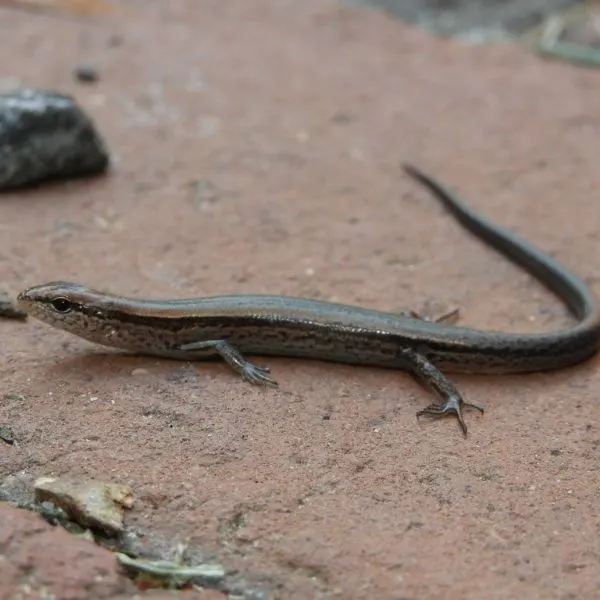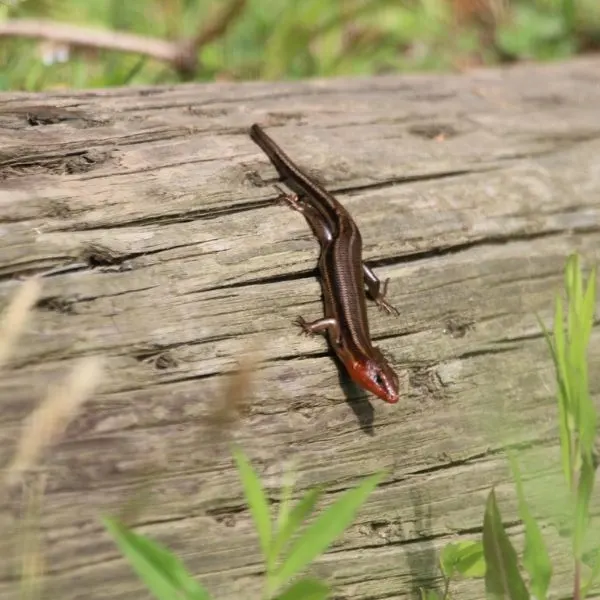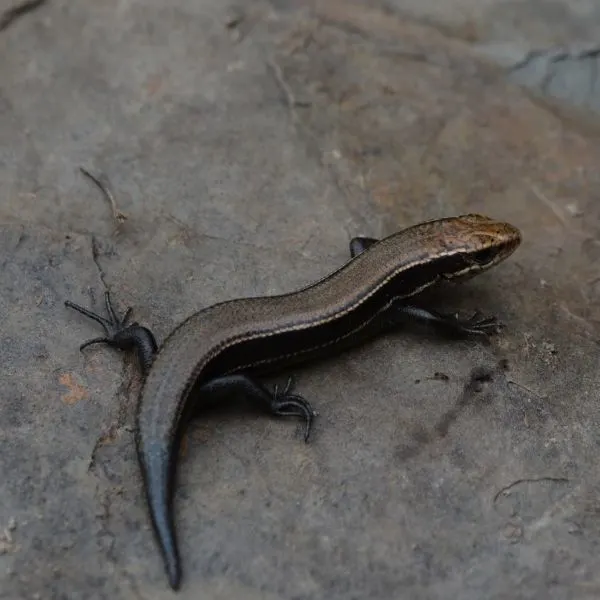There are 4 different types of skinks in Maryland. Skinks are the most diverse lizards in this state, accounting for 4 of the 7 lizard species.
You can find skinks in many types of habitats across Maryland. However, most prefer moist forest areas with adequate leaf litter and fallen trees. Some species also wander around residential areas.
It is easy to mistake a skink for a snake if you only catch a glimpse of the lizard. Skinks have similar wave-like movements, and the streamlined bodies of some species can make it hard to see their legs.
While some species are indeed legless, none of the skinks in Maryland are. In addition, skinks pose none of the threats snakes pose. They typically run from predators and only resort to biting if they have no means of escape.
These lizards have an escape tactic called autotomy. When chased or grasped by predators, skinks intentionally detach their tails. The tails thrash about, distracting the predator while they escape.
In this article, you will learn about the types of skinks in Maryland. You will also learn some interesting facts about them and how to identify each one.
Table of Contents
Skinks in Maryland
1. Little Brown Skink

- Experience Level: Advanced
- Family: Scincidae
- Scientific Name: Scincella lateralis
- Other Names: Ground Skink
- Adult Size: 3 to 5.75 inches
- Lifespan: 2 to 4 years
- Average Price Range: N/A
Little brown skinks, as the name suggests, are brown. They are typically copper brown, but you can find many members with golden to dark brown skins. In addition, these skinks have yellow or white undersides and a broad, dark stripe running the length of their bodies on each side.
These lizards live in moist habitats with loose soil. You will often find them in forests with plenty of leaf litter, fallen trees, and rotting logs. These places provide good hiding spots for them.
While little brown skinks can climb, they spend all their time foraging on the ground. They never climb trees but bask on the forest floor when they need to. This attachment to the ground is why they are also called ground skinks.
These lizards alternate between staying on the surface and traveling under heaps of leaves and debris in their habitats. They have a clear scale on each lower eyelid, enabling them to see under this debris even with closed eyes. Other skinks in Maryland lack this feature.
Little brown skinks are adept at escaping predators. First, moving under leaves and debris affords them stealth, so they can escape predators without surfacing to reveal their precise position.
In addition, these lizards have the highest success using autotomy to escape predators among skinks in Maryland. Their tails thrash longer and more vigorously than other skinks in Maryland, distracting predators for longer while the lizards escape unharmed.
Ground skinks are the only skinks in Maryland that look the same at all life stages. They do not exhibit the same dramatic coloration change the others undergo between juvenile and adult stages.
You can feed ground skinks with arthropods of various kinds. In addition, they eat other small invertebrates like waxworms and mealworms.
2. Common Five-lined Skink

- Experience Level: Beginner to Intermediate
- Family: Scincidae
- Scientific Name: Plestiodon fasciatus
- Other Names: American Five-lined Skink, Five-lined Skink
- Adult Size: 5 to 8.5 inches
- Lifespan: 6 to 10 years
- Average Price Range: N/A
Five-lined skinks are the most common skinks in Maryland in most states in the US. You can often find them in residential areas basking on walls or foraging in people’s gardens.
While they are cosmopolitan about where they live, these skinks favor natural habitats with plenty of moisture. They enjoy living in forests with plenty of leaf litter and rotting logs. Adult females tend to lay eggs in these logs.
Common five-lined skinks are comfortable on the ground, but they also climb trees to bask in the sun or hunt for prey. Their diets contain mainly arthropods. However, these lizards eat various food types, from worms to tiny lizards.
If you keep one of these skinks, you could include some fruit and vegetables in small portions once in a while. Adding variety to its diet enriches it with other vital nutrients.
Skinks are easy to care for, although many people who try to keep them as pets end up with dead skinks soon. Unfortunately, that often happens because they do not do the required work.
Besides feeding them well, ensure their enclosures are optimal. So make the place well wooded and include basking spots for these lizards. Also, install UV lighting to provide an alternate source of sunlight and warmth.
Juvenile and adult female five-lined skinks have five thin yellowish stripes running down their back and sides. Juveniles have black skin with bright blue or purple tails. The tail coloration fades in adults, and females become dark brown instead of black.
Adult males are lighter than females and juveniles. They also lack blue tails, and most have only hints of the stripes on their bodies. In many older males, the stripes disappear entirely, leaving the body uniformly bronze or brown.
3. Broad-headed Skink

- Experience Level: Advanced
- Family: Scincidae
- Scientific Name: Plestiodon laticeps
- Other Names: Broadhead Scorpion, Five-lined Skink, Broadhead Skink
- Adult Size: 6 to 13 inches
- Lifespan: 6 to 10 years
- Average Price Range: N/A
Broadhead skinks are like common five-lined skinks in many aspects. However, these lizards are bigger. They are the biggest skinks in Maryland. In addition, adult males have broad, triangular heads with orange jaws.
Juveniles and adult females are more difficult to tell apart from common five-lined skinks. Both lizards have five light dorsolateral stripes, and juveniles have black skin with blue tails.
Adult female five-lined skinks retain the lines, while males typically do not. Both lose the juvenile tail coloration and develop brown ground colors. However, adult females are much darker than males.
Broadhead skinks are fiercely territorial lizards. As a result, it is common to see adult males fighting over territory and mating rights. Fortunately, these skinks do not extend their hostility to female broadheads.
The heads of adult broadheads turn bright red-orange during breeding seasons. However, the intensity fades once the breeding season is over.
You can keep these lizards in home terrariums for display. Unfortunately, they do not enjoy handling much. They will run or bite you when you try to hold or pet them. So they are not great as cuddly pets.
Ensure the terrarium of any broadhead skink you keep is as close to its natural habitat as possible. These lizards love moist, well-wooded places with high basking spots. In the wild, you will often find them basking on tree branches.
In addition to providing this skink with elevated basking spots, make sure to install UV lighting to substitute for natural sunlight.
Although broadhead skinks feed primarily on insects and arthropods, you can add other vitamin D-rich foods to their diets. This gives them extra nutrients lacking in arthropods. These lizards also eat other tiny invertebrates and vertebrates.
4. Coal Skink

- Experience Level: Advanced
- Family: Scincidae
- Scientific Name: Plestiodon anthracinus
- Other Names: Northern Coal Skink, Black Skink
- Adult Size: 5 to 7 inches
- Lifespan: 6+ years
- Average Price Range: N/A
You can find coal skinks in Maryland, but their numbers are few. That is why the state has categorized them as endangered species. Habitat loss and naturally minute populations are responsible for their rarity.
Coal skinks are secretive lizards with an affinity to hiding under rocks and debris. As a result, their natural habitats are often moist forests and coastal areas with plenty of surface leaves, grasses, logs, and other debris.
You will rarely find this skink out in the open. It does most of its foraging beneath the debris in its habitat. However, it stays close to its shelter when out in the open. It seeks cover at the slightest sign of a potential predator.
Coal skinks are born jet-black with bright blue tails and white markings on their heads. Young coal skinks often lack the stripes of adults, but some may have faint traces.
These lizards lose their tail coloration as they mature into adults. In addition, the black skin lightens to brown and reveals four thin light lines—a pair on either side. This pattern makes it a four-lined skink.
The middle of each pair of light lines has a broad, dark stripe that runs the body’s length and extends to the snout.
There are no other four-lined skinks in Maryland, so this species is easy to identify. However, sometimes it can be hard to differentiate them from female five-lined skinks that have lost their dorsal stripe.
In such cases, you can distinguish coal skinks by counting the number of their scales. For example, coal skinks have 1 postmental scale, while five-lined skinks have 2.
Coal skinks feed on mainly insects and arachnids within their habitat. However, those close to streams may also consume crustaceans.
Frequently Asked Questions
You probably have many questions about the skinks in Maryland after reading this article. Or maybe you need clarifications about specific issues.
This section contains clear answers to all your questions.
How do you identify skinks?
You can identify skinks by their body pattern and shape. These lizards have long, streamlined bodies that make them seem like snakes from afar. In addition, skinks have reduced but functional limbs and smooth, shiny scales. They tend to move in an undulating or wavy manner.
How rare are skinks in Maryland?
Skinks are generally not rare in Maryland, but some species are. For example, coal skinks are extremely rare to come across, both due to their large numbers and their secretive nature.
However, other skinks like five-lined and little brown skinks are abundant in the state. You can easily find many of them if you check their natural ranges.
What do skinks in Maryland eat?
Skinks in Maryland mainly eat arthropods like spiders, roaches, crickets, ants, and beetles. However, these lizards consume various other kinds of food.
Many skinks eat small invertebrates like worms and vertebrates like lizards and other tiny reptiles. In particular, broadhead skinks eat lizards of several species, including theirs. For instance, immature broadhead skinks are sometimes victims of cannibalization from adults.
You can also feed skinks in Maryland fruits and vegetables in small amounts. Variety in a skinks diet helps it gets many nutrients, but do not overdo it.
Are skinks in Maryland poisonous?
No. Skinks in Maryland are not poisonous. Regardless of location, all skinks are harmless to humans. While some bite if provoked or mishandled, these bites are nonvenomous, even if painful.
It is common to find people who believe some species of skinks in Maryland are venomous due to their appearance. Unfortunately, juvenile blue-tailed skinks are often victims of this speculation. But that is all it is—speculation. These lizards are entirely safe.
Where are skinks found in Maryland?
You can find skinks in most parts of Maryland. Several species, such as five-lined and broadhead skinks, are distributed throughout the state. However, other species like coal skinks are more challenging to locate.
If you are interested in finding a particular type of skink in Maryland, ensure to research its specific geographical locations. Different species have different geographical ranges within the state.
Can you own a pet skink in Maryland?
Yes. However, only some species can be acquired legally. The Maryland Department of Natural Resources has three reptile lists: A, B, and C.
You can own up to 4 skinks from list A species without a permit, such as five-lined skinks and ground skinks. However, you need a permit to hold more than four of these skinks.
You also need a permit to own list B and C skinks like coal skinks broadhead and coal skinks. But, sadly, you are unlikely to get a license for endangered species.
You do not need a permit for skinks not native to Maryland.
Wrapping up
Maryland is home to 4 diverse skinks. These skinks differ in pattern, color, distribution, and behavior. However, despite these differences, most skinks in Maryland are alike in many ways, such as their diet and shape.
Fortunately, you can adopt some species of skinks in Maryland. However, while you can collect some skinks from the wild, it is better to get captive-bred skinks from authorized dealers in the state.
Captive-bred skinks tend to have fewer parasites than wild skinks. They are also easier to tame. If you keep a skink, ensure you care for it properly. Ensure it has sufficient lighting, moisture, and vegetation to make it comfortable.
Always research skinks before buying them. While skinks are generally low-maintenance, some species are cheaper and easier to keep than others. For example, some require UV lighting while others do not.
Luckily, there are many resources to help you learn about skinks. We hope this guide has succeeded in increasing your knowledge about the skinks in Maryland.
Skinks in other states
- Skinks in Alabama
- Skinks in Georgia
- Skinks in North Carolina
- Skinks in South Carolina
- Skinks in Virginia

Ruti Rosenbloom
Monday 18th of September 2023
My kids informed me they found a gecko near a spout on out walk way. I observed its body shape and noticed it had the snake-like form of a skink. We took picture and from the descriptions I read, the only one that fits is a young, slightly matured coal skink. I live outside northwest Baltimore. So, I am surprised that it matches this description. Where can I send a picture to confirm the species?